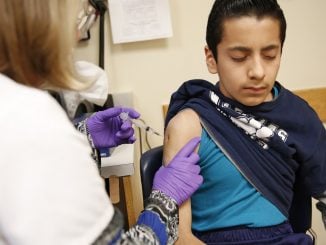RALEIGH — The N.C. Department of Health and Human Services (NCDHHS) updated the guidance for K-12 schools to include “Test to Stay” options on Jan. 7.
“Protecting our students and staff requires layers of protection to stop the spread of COVID-19,” said State Health director and chief medical officer Elizabeth Cuervo Tilson, M.D. “In addition to vaccines and masks, Test-to-Stay is another proven tool that can help minimize the spread of COVID-19 while also maximizing time in the classroom.”
Near the end of 2021, NCDHHS updated guidance to mirror Centers for Disease Control (CDC) shortened quarantine measures.
The StrongSchoolsNC Toolkit (SST) has now been updated to allow students and staff who had a close contact with someone confirmed to have a case of COVID-19 to remain in school if they have not developed symptoms or tested positive.
“Individuals in a mask-required school setting do NOT need to be excluded from school after a close contact, including unmasked exposures (e.g., during lunch or extracurricular activities), if they have no symptoms,” reads the updated section of the SST.
The qualifying criteria given by NDHHS for staying in school under “Test to Stay” are as follows:
- The person exposed has had their COVID-19 vaccinations. For adults 18 and up, vaccination includes booster shots.
- The person exposed has had a confirmed case of COVID-19 within the last 90 days and has no symptoms.
- The person exposed and the person with a confirmed case of COVID-19 were both properly wearing masks when the exposure occurred.
According to the NCDHHS press release, adding “Test to Stay” has expanded the list of scenarios to include unmasked exposures such as when students unmask to eat lunch.
The Jan. 7 update also says that “Individuals with unmasked exposures in a mask required school setting should get tested on the day of notification of exposure and as close to day 5 after exposure as possible and must wear a mask in school settings.” Additionally, that exemption “applies to in-school exposures as described above as well as non-household, out-of-school exposures.” In-household exposures do not qualify, but the new guidance gets more confusing, stating that a person doesn’t need to be excluded from the school setting but that “quarantine measures may still apply in non-school settings.”
The update also gives priority for testing to student athletes due to higher risk of exposure “if testing supply is limited.”
NCDHHS says this Test-to-Stay option “only applies to K-12 school settings that require masks,” which the agency claims “data has shown limits the risk of transmission.”
Districts taking part in “Test to Stay” will ensure those exposed to COVID-19 get tested the day they are notified of an exposure and again five days after. They should also wear a mask for 10 days following exposure and except for going to school, they should stay home and isolate.
The Center for Disease Control’s quarantine and “Test to Stay” guidance also uses 10 days of masking following an exposure.
Various media reports cite experts claims that cloth masks, which the public has been using from close to the start of the pandemic, are ineffective against the omicron variant. The push to continue masks as a requirement to keep kids in school was brought up and questioned at the State Board of Education meeting on Jan. 6.
During that meeting, Tilson said she had provided some studies which show that masks work in “totality.”
Tilson was asked specifically about cloth masks versus N95 masks. Currently, N95 masks are not designed for children. She said that “anything on your face is better than nothing” and that “multi-layered, well-fitting cloth masks still provide good protection.” She admitted there was data that said an N95 provided more protection.
“With children, what is particularly important is the comfort and the fit of that face covering,” Tilson told the board. She added they have N95 masks available at NCDHHS warehouse to give to adult school staff and that for students “a multi-layered, well-fitted cloth mask” still “provides good protection.”
Board member Olivia Oxendine asked where natural immunity falls in NCDHHS’ school guidance. Tilson did not directly answer the question, and instead cited “lowered” and “inconsistent” protection from prior infections against the omicron variant.
The change to the SST comes as states like Georgia are dropping quarantine and contact tracing for K-12 schools.
According to the Associated Press, Georgia’s governor and public health commissioner released a letter on Jan. 6 stating school employees no longer have to quarantine after exposure, even if they are unvaccinated or test positive for the virus if they wear a mask and don’t develop symptoms.
“The letter also says contact tracing in schools is now optional, meaning schools may no longer have to notify other students or employees exposed to people who are sick with COVID-19,” the Associated Press reported.



